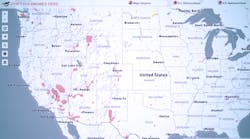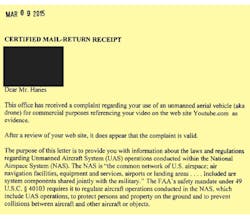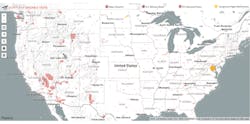This file type includes high resolution graphics and schematics when applicable.
Pilots are getting tickets, airports are getting angry, and businesses are losing money. Why? The simple answer: drones and the Federal Aviation Administration (FAA). There are a lot of regulations and rules concerning drones, or small unmanned aircraft systems (sUAS) as the FAA refers to them, but what exactly do all of these regulations mean? Hobbyists and businesses alike are shaking their heads in confusion asking themselves, “What’s going on?” Well, Buy the Best Drone is here to help. This guide will walk you through the major takeaways of FAA policy and give an in-depth analysis of how the FAA is treating consumer and business use of drones using real-life examples.
Consumer vs. Commercial Drones, According to the FAA
The FAA currently does not allow commercial use of drones except under special circumstances. Consumer drone use is completely legal if used according to FAA guidelines. So what exactly constitutes commercial use (or use by a business to specifically make money off drones)?
Using an unmanned aerial vehicle (UAV) to take a video of the ocean pier while visiting San Diego with the family is completely legal (as long as you’re not in a no-fly zone). However, if you go online and attempt to sell that same video, you’re breaking the law.
Recently, a pilot named Jayson Hanes took a nice aerial video of the Everglades and posted it on YouTube. One day he returned home to find a letter in his mailbox stating that the videos he was posting online were considered unlawful commercial use of his sUAS.
Here’s the video:
According to Motherboard, “If you fly a drone and post footage on YouTube, you could end up with a letter from the Federal Aviation Administration.”
Jayson Hanes wasn’t attempting to use his drone for commercial use or sell his footage; he was only attempting to share it. Yet, he ended up in the hot seat, facing a large fine for posting his videos on a public sharing service. The video had ads on it, ads that YouTube ad services placed and he was never paid for, but ads nonetheless.
Here’s a snippet of the letter they sent Jayson (Fig. 1). You can read the whole document here.
Is this fair? I’d certainly say it isn’t. But the FAA is the FAA and they can do what they please, until the courts get involved.
What did the FAA forget when drafting their legislation? Well, frankly, they forgot the First Amendment, which became clear in FAA v. Raphael Pirker. Raphael Pirker used a drone to film an advertisement for the University of Virginia and ended up getting fined $10,000 by the FAA. Unfortunately for the FAA, they ended up paying him $1,100 after Pirker and his lawyer argued that the FAA was hindering Pirker’s freedom of press.
Here’s some nice language from the brief:
“The federal government has deprived its citizens and a free and independent news media of the opportunity to participate in the rulemaking process required under U.S. law when the government seeks to regulate, restrict, or curtail otherwise proper lawful activity. The federal government, through the FAA and with the NTSB’s encouragement, should move forward with the development of policies that protect, rather than hinder, freedom of speech and of the press.”
Looking at Hanes and Pirker, we see the FAA seriously attempting to intervene in sUAS use—almost to an absurd level. Is the FAA really spending their time wisely hunting down a guy posting his videos on YouTube? You tell me. Either way, it seems the line between commercial and consumer use is fairly fuzzy. Let’s recap with a couple of points to help us better understand what is and isn’t okay:
• Is anyone (not even just you) making money off of your drone use? Looking at Hanes’ case we see the FAA wouldn’t tolerate even a third-party service making money off aerial photography shot by a drone. Does this mean you shouldn’t share your videos online? No, but be careful where you share them and make sure you don’t sell them.
• As an actual business, you’re really only safe if you’ve been personally cleared by the FAA. ABC News reports that since last September, the FAA has cleared more than 200 commercial cases for drone use. Does that mean it’s an easy process to get cleared? Absolutely not, but I wouldn’t expect the strict regulations to last too long.
Commercial Drone Use
The FAA has some specific (and some not so specific) guidelines concerning the use of sUAS. Here are some things you definitely can’t do according to current policy:
• Sell photos or videos, i.e. wedding or concert photography
• Use drones to carry out services, such as inspections or farming services
• Use drones for any other professional services, such as security and deliveries
The FAA also released a long-awaited sUAS policy proposal in February. After missing its deadline, it finally provided the public with some information. The policy states:
• Drones for commercial purposes must be under 55 pounds
• The pilot must be able to see the unmanned aircraft at all times
• Unmanned aircraft flight must be conducted during the day
A summary of the proposal can be found here. This is currently just a proposal and therefore will not be the official FAA policy on drones for commercial use until it’s approved. If this does stand, Amazon will not be using its PrimeAir service (Fig. 2).
Consumer Drone Use
So you’re not a business and you just bought your first sUAS. You’re excited to hit the sunny skies and soar over the landscape capturing 720p streaming videos and watch them afterwards. This means you have nothing to worry about, right? Think again.
Not only are there restrictions of where you can fly your drone and how you can fly it, you also need to be extremely respectful of the community and area you’re flying it in. Many citizens condemn the use of drones, stating they are clear invasion of privacy and should be banned completely. If you fly over someone’s backyard who has a shotgun, we’re not going to feel bad. We’re going to say “I told you so.”
First of all, don’t fly in a no-fly zone area (Fig. 3). The FAA invested time and money to develop a map for novice pilots to use at their disposal. It’s a great resource.
There’s also Air Map—an interactive web app that allows you to see in real-time if your flight is interfering with any flight regulations. The map allows you to layer your flight path with different airspace regulations, allowing every pilot to know if the area they’re flying is restricted, or if they need to contact an air-traffic controller, or simply shouldn’t be flying there.
Other areas to stay away from are U.S. National Parks and U.S. military bases. Drone flight is illegal in both.
Here are a few other quick tips to help your consumer flight safe and avoid getting a ticket:
• Stay under 400 feet
• Contact any airport if you’re within five miles
• Keep your drone within eyesight
• Don’t fly inebriated or under any other sort of intoxication
• Respect other people
• Stay clear of power stations, prisons, or anything similar (use common sense)
Conclusion
Overall, use your head. If you think you’re disturbing anyone else, messing with wildlife, or endangering other pilots, it’s probably not a good idea.
Here are a couple of key takeaways:
• Don’t try and monetize your drone use unless you’re an FAA-approved commercial business.
• It’s possible to receive punishment even if you’re not specifically making money off your drone use (as in Jayson Hanes’ case).
• 200 businesses have been approved for commercial use.
• Don’t fly by airports (and if you do, contact them first).
• Don’t fly drunk or on drugs.
• The FAA is trying to help you, reach out to them if you have any questions.
• Have fun.
This file type includes high resolution graphics and schematics when applicable.
References:
http://buythebestdrone.com/drone-policy-2015-guide-drone-rules-faa-regulations/





